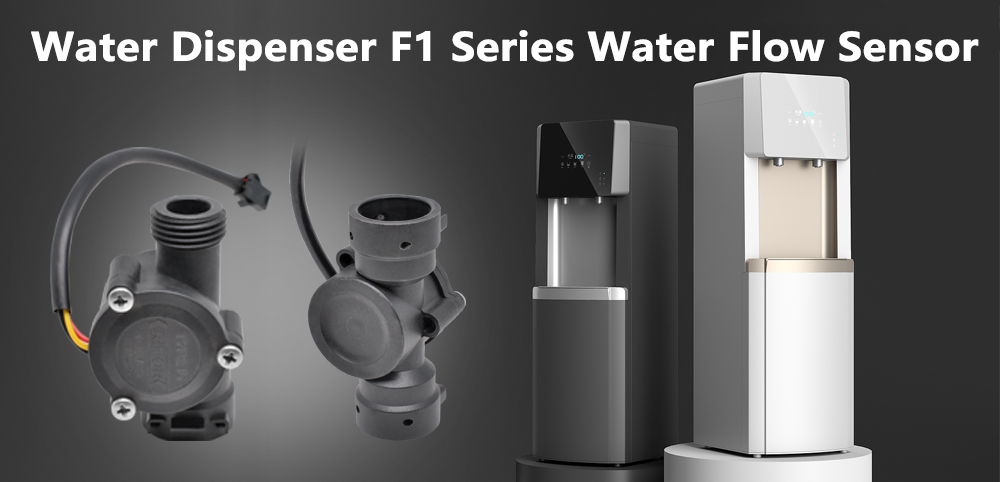Importance of F1 series water flow sensors in Water Dispensers
An F1 series water flow sensor is a crucial component in any water dispenser, as it regulates the flow of water from the source to your glass. Without a properly functioning flow sensor, you may experience inconsistent water flow or even complete water flow blockage. This can be frustrating and time-consuming, especially during busy moments when you need a quick refill.
F1 series water flow sensors in water dispensers are designed to monitor the rate of water flow and adjust it accordingly to provide a seamless and efficient experience. By accurately measuring the flow rate, these sensors ensure that you get the desired amount of water without any delays or interruptions.

How F1 series water flow sensors Work
F1 series water flow sensors work on the principle of fluid dynamics, utilizing a paddle wheel or a turbine to measure the speed of water passing through. As the water flows, it causes the paddle wheel or turbine to rotate. The sensor then converts this mechanical movement into electrical signals, providing real-time data about the water flow rate.
These electrical signals can be further processed by the dispenser’s control system to regulate the water flow, ensuring a consistent and steady stream. Additionally, some advanced F1 series water flow sensors are equipped with built-in temperature sensors, allowing for precise control of both flow rate and water temperature.
Table of Contents
Toggle- Benefits of Using F1 series water flow sensors in Water Dispensers
- Factors to Consider When Choosing an F1 series Water flow Sensor for a Water Dispenser
- Installation and Calibration of F1 series water flow sensors in Water Dispensers
- 4. Connect the Wiring
- Maintenance and Troubleshooting Tips for F1 series water flow sensors in Water Dispensers
- The Future of F1 series water flow sensors in Water Dispensers
Benefits of Using F1 series water flow sensors in Water Dispensers
The use of F1 series water flow sensors in water dispensers offers numerous benefits for both consumers and businesses. Here are some key advantages:
1. Enhanced Convenience and Time Saving
With an F1 series water flow sensor, you no longer have to wait endlessly for water to fill your glass. The sensor ensures a swift and continuous flow, allowing you to quench your thirst without any unnecessary delays. This convenience is particularly valuable in high-traffic areas or during events where quick access to water is essential.
2. Improved Efficiency and Cost Savings
By accurately measuring the water flow rate, these sensors prevent wastage and promote water conservation. They enable precise control over the amount of water dispensed, reducing unnecessary consumption and lowering utility costs. This not only benefits the environment but also contributes to long-term cost savings for both households and businesses.
3. Reliable Performance and Durability
F1 series water flow sensors are engineered to withstand the demands of daily use, ensuring reliable and consistent performance over time. These sensors are designed to be resistant to corrosion and scale buildup, ensuring accurate readings and uninterrupted water flow. With their durable construction, they can withstand the rigors of continuous operation without compromising accuracy or efficiency.
Factors to Consider When Choosing an F1 series Water flow Sensor for a Water Dispenser
When selecting an F1 series water flow sensor for your dispenser, several factors should be considered to ensure optimal performance and compatibility. Here are some key considerations:
1. Flow Rate Range
Different water dispensers may require varying flow rates. It is essential to choose a flow sensor that can handle the expected flow rate range of your dispenser. Ensure that the selected sensor can provide accurate measurements within the desired flow range to avoid any operational issues.
2. Accuracy and Precision
The accuracy and precision of the flow sensor are crucial for maintaining consistent water flow. Look for sensors that offer high accuracy and a low margin of error. This ensures that you get the exact amount of water you need, without any overflows or underflows.
3. Material Compatibility
Consider the materials used in the construction of the flow sensor. It should be compatible with the type of water dispensed, such as tap water or purified water. Some sensors may not be suitable for certain water types, leading to inaccurate readings or performance issues.
4. Installation and Maintenance
Opt for a flow sensor that is easy to install and maintain. Look for sensors that come with clear installation instructions and require minimal upkeep. This will save you time and effort in the long run, ensuring hassle-free operation.
Installation and Calibration of F1 series water flow sensors in Water Dispensers
Installing an F1 series water flow sensor in your water dispenser might seem like a daunting task, but it can be relatively straightforward with the right guidance. Here’s a step-by-step guide to help you through the process:
1. Choose the Right Location
Select a suitable location on the water dispenser where the sensor can be easily integrated into the water flow path. Ensure that it is accessible for installation and future maintenance.
2. Prepare the Water Dispenser
Before installation, turn off the power supply and water source to the dispenser. Empty any remaining water from the system to prevent leaks or spills during the installation process.
3. Mount the Sensor
Attach the flow sensor to the designated location on the dispenser, following the manufacturer’s instructions. Ensure a secure and stable attachment to prevent any movement or dislodging during operation.
4. Connect the Wiring
Connect the wiring of the flow sensor to the dispenser’s control system or circuit board. Follow the wiring diagram provided by the manufacturer to ensure proper connectivity.
5. Calibrate the Sensor
Once the sensor is installed, it needs to be calibrated to accurately measure the flow rate. Consult the sensor’s manual for specific calibration instructions. This may involve adjusting settings or entering calibration values into the dispenser’s control system.
6. Test and Adjust
After calibration, test the dispenser to ensure that the water flow is consistent and accurate. Make any necessary adjustments to the calibration settings until the desired flow rate is achieved.
Maintenance and Troubleshooting Tips for F1 series water flow sensors in Water Dispensers
To maintain optimal performance and extend the lifespan of your F1 series water flow sensor, regular maintenance is essential. Here are some maintenance and troubleshooting tips to keep your sensor in top condition:
1. Periodic Cleaning
Clean the flow sensor regularly to remove any debris or sediment buildup that may affect accuracy. Follow the manufacturer’s guidelines for cleaning procedures and recommended cleaning agents.
2. Inspect for Damage
Regularly inspect the sensor for signs of damage or wear. Check for loose connections, cracks, or any other visible issues that may impact performance. Replace any damaged parts promptly to prevent further complications.
3. Monitor Flow Rate
Keep an eye on the flow rate displayed on the dispenser’s control system. If you notice any significant deviations or inconsistencies, it could indicate a problem with the flow sensor. Consult the troubleshooting guide provided by the manufacturer for potential solutions.
4. Check for Leaks
Inspect the sensor and surrounding areas for any signs of leaks or water seepage. Leaks can compromise the accuracy of the flow sensor and lead to water wastage. Address any leaks promptly to prevent further damage.
The Future of F1 series water flow sensors in Water Dispensers
As technology continues to advance, F1 series water flow sensors are expected to become even more efficient and intelligent. Future developments may include:
Integration with smart home systems, allows users to monitor and control water flow remotely through their smartphones or voice assistants.
Enhanced connectivity options, enabling seamless integration with other smart devices in the home or office environment.
Advanced data analytics capabilities, providing valuable insights into water consumption patterns and promoting further conservation efforts.
With these advancements, F1 series water flow sensors will not only improve the efficiency of water dispensers but also contribute to overall sustainability and resource management.
